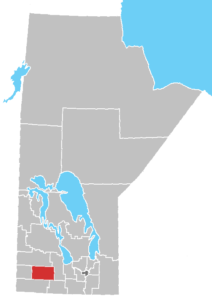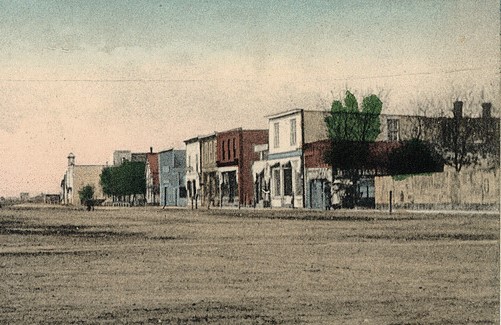THE SETTLEMENT:

The map shows the state of Manitoba. The red square shows the current Glenboro – Southern Cypress district that was formed in 2015. Winnipeg is marked in black.
The South Cypress Settlement was situated in southwestern Manitoba. From the eastern boundary of the settlement, it was 152 km (94 miles) to Winnipeg, but from the border of Canada and the United States to the southern boundary of the settlement was almost 60 km (37 miles). From the eastern border to the western border were 38 km (24 miles) and from north to south were 29 km (18 miles). To the south was a very fertile agricultural area, but in the north the land was almost uninhabitable on both sides of the Assiniboine River, which winds from west to east along the length of the settlement. It can be said that the river flows through a shallow valley where land higher up is fertile. Up from this valley, sand dunes in most places are covered with grass and forest. The settlement is divided into two smaller ones, the Hola Settlement (Hólabyggð) and the Glenboro Settlement (Glenborobyggð).
Settlement in Hóla began in 1889 and ended in 1894. This settlement actually grew out of the Argyle Settlement, which was then completely inhabited. When the whole area was settled, there were 26 homes there and it has never been so crowded since.

Broadway Ave. in Glenboro early in the 20th century. Photo: Prairie-Towns
GLENBORO:
Glenboro was chosen because of the railway that ran through the southern part of Manitoba and was laid there in 1886. The Icelandic settlement is as old as the first settler in the village, Friðjón Friðriksson, who came with the first train. The town has always been neat and well kept. It stands on the plain near the southern border of the settlement. To the southeast are the “Tiger Hills” but to the north are sand dunes along the Assiniboine River, which flows east into the Red River in Winnipeg. Glenboro is about five km (3 miles) from the river. The population has never been large, it was highest with around 500 people in 1836 and 200 of them were Icelanders. The town soon became one of the main shopping places for Icelanders in Hólar and Argyle Settlements, but residents in the Argyle Settlement soon turned to Cypress River and Baldur. In 2015, the village was incorporated into the South Cypress community and is now called the Glenboro – South Cypress District.
Trade and administration:
From the beginning, Icelanders took an active part in the town’s business life. Friðjón Friðriksson took the lead soon after he came to the village and opened a shop. It flourished for about 20 years under his management. Other Icelanders then took over the operation and it was named Sigmar Bros. & Co. This store was large and comprehensive, but many smaller ones were run by Icelanders that were more specialized, e.g., bakery, shoe store, hardware store and the like. Icelanders have long been represented in local councils, town councils and school councils. The town newspaper was in the hands of Icelanders for a long time and Icelanders have been secretaries of the court and justices of the peace.
Icelandic congregations and society:
The preservation of the Icelandic heritage was immediately a matter of great importance, and a reading society was established almost immediately. It was soon robust and active for a long time with great prominence. Church affairs were soon on the agenda, but this was always in the hands of the settlers themselves. Priests from elsewhere visited the inhabitants of the settlement usually once a month and Reverend Friðrik Hallgrímsson was very involved. The Glenboro congregation was finally formally founded in 1919 and it greatly strengthened all Icelandic social activities. In 1925, the congregation started building a meetinghouse, which was also the home of the parish priest, who also served in Argyle. A women’s association was soon established at the beginning of the settlement years and was another strong element in social life. The society came to an end after the turn of the 20th century, but another was founded on April 29, 1914.
English version by Thor group.
